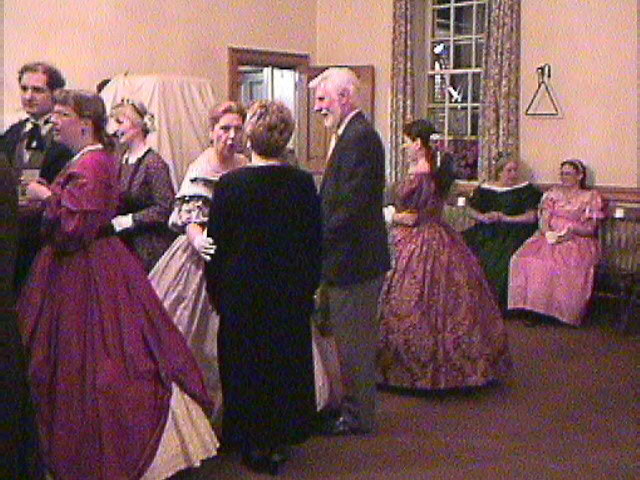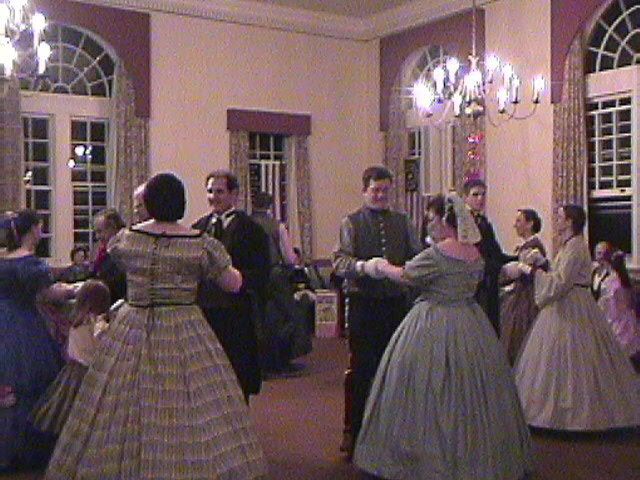
Civil War Dance Society
Dance Etiquettes
Last Updated on
April 24th, 2005
by
Kurt Grauf


The
Victorian Era
basically covers the time period between 1837-1901 during the
longest running female reigns for the vast British Empire. Queen Alexandrina
Victoria was the only child of Edward, Duke of Kent, and Princess Victoria Maria
Louisa of Saxe-Coburg. Queen Victoria was born May 24, 1819, and took the throne
upon the death of her uncle William IV at the youthful age of 18. The Victorian Era,
as we refer to it today, describes things and events during Queen Victoria's reign:
“a sense of rebirth of the Romantic emphases on self, emotion and imagination--a time
of Neoclassical reflection of gentile and graceful appearances towards the arts.”
Let’s take
a moment and look back in time to the 1860s during the American Civil War when two
apposing armies clashed on farmer’s fields, in villages and on the high seas. Although
the war had deepen family despairs and hardships, there was a sense of self-worth,
patriotism, and community involvement. Young or old, rich or poor, social entertainment
was looked forward to and encouraged.
 Today,
when we are thinking of dancing, we may imagine a large dance hall or perhaps dancing
under a tent or pavilion. Traditionally, a wealthy landowner’s wife would host a formal
gathering in a family’s house filled with delightful candles, chatter, and light
refreshments. It was expected to make everyone happy and cheerful in order to forget the
raging war even for a few hours. A friendly place to meet neighbors and friends or even
to meet newcomers. North or South, East or West, in the Americas or in Europe, it’s just
a point on a compass. Music and dance were very much similar. Moreover, much of the dances
of this time period originated in either England or France.
Today,
when we are thinking of dancing, we may imagine a large dance hall or perhaps dancing
under a tent or pavilion. Traditionally, a wealthy landowner’s wife would host a formal
gathering in a family’s house filled with delightful candles, chatter, and light
refreshments. It was expected to make everyone happy and cheerful in order to forget the
raging war even for a few hours. A friendly place to meet neighbors and friends or even
to meet newcomers. North or South, East or West, in the Americas or in Europe, it’s just
a point on a compass. Music and dance were very much similar. Moreover, much of the dances
of this time period originated in either England or France.
It was not uncommon for a husband and wife to come
to a dance with only dancing once
with that spouse. It was socially acceptable, if not encouraged, to mingle with
others: married or single. In fact, it was not uncommon for a married lady to dance
with a young, dashing gentlemen or vs. a married gentleman to entertain a young maiden.
For single ladies it was a formal setting to meet a potential husband. For a young
lad it was a way to check out, shall we say, the local availability.
When approaching a building a gentleman would
remove his hat and always during
instructions to a lady. Gentleman would wear his finest suit, tie, hat and, of
course, clean gloves. Ladies would wear their finest dresses and wear bonnets, hats,
or even flower headbands. Ladies would curtsey when being first introduced to a
gentleman. In order for a single male to approach a single lady, it was done purely
with introductions and usually a married lady or a distinguishing gentleman introducing
the young couple.
Prior to the dance a gentleman would ask the lady
for her dance card. Naturally, he
would pick an available dance that he was proficient in order to impress the lady. For
a lady it was ill-mannered to turn-down a dance unless fatigue or ill overpowered her.
Of course, repugnant, distasteful or nongentleman-like characteristics would be a valid
excuse for refusal.
In public couples never touched hands without proper gloves. Gloves served two
purposes: looks dashing and, most important, to keep the oily palms off the ladies’
dresses. It was improper and unthinkable to leave a hand-print on a person's attire.
In addition, it was difficult to hand-wash and, for that matter, remove the oily print
from the expensive fabric.
 In a “closed position” the gentleman would open his left hand in an “U” shape and
extend towards the lady. The lady would place her right hand through the “U” shape.
The gentleman would place his hand on the lady’s back, and the lady would lay her
left hand on the gentleman’s right shoulder.
In a “closed position” the gentleman would open his left hand in an “U” shape and
extend towards the lady. The lady would place her right hand through the “U” shape.
The gentleman would place his hand on the lady’s back, and the lady would lay her
left hand on the gentleman’s right shoulder.
When escorting a lady, the gentleman may have his right palm upwards and the lady
will rest her left hand on his. For a more formal setting, a gentleman's palm will
face downwards and the lady will rest her left hand on his.
This concludes a belief introduction to the
social graces and dance etiquettes discussion. If you have additional questions,
please feel free to contact Kurt Grauf
by either telephone or by email.


All information is borrowed in good-faith from various websites and for use as historic informational purposes only.
Two main sources are respectfully borrowed from
Victorian Station
and
Kings and Queens of the United Kingdom.
Borrowing information from this website is granted upon obtaining permission from
Civil War Dance Society.